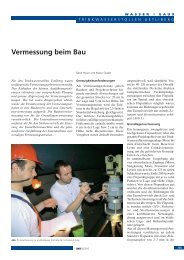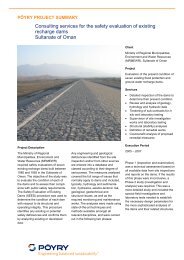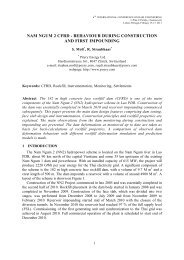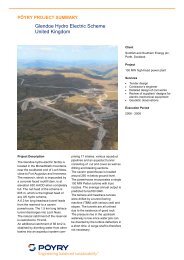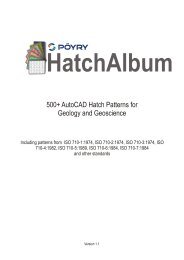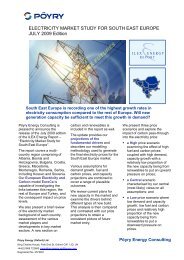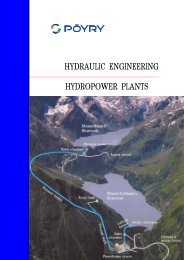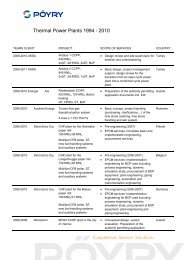EARTHQUAKE SAFETY EVALUATION OF ATATURK DAM
EARTHQUAKE SAFETY EVALUATION OF ATATURK DAM
EARTHQUAKE SAFETY EVALUATION OF ATATURK DAM
Create successful ePaper yourself
Turn your PDF publications into a flip-book with our unique Google optimized e-Paper software.
The earthquake analysis of the dam consisted of the following steps:<br />
1. Generation of input ground motion (in the form of artificial spectrum-compatible accelerograms)<br />
corresponding to the MCE, which was selected on the basis of the available information about the<br />
seismic hazard at the dam site<br />
2. Assessment of the following dynamic properties of each dam material<br />
• Maximum dynamic shear modulus (i.e. shear modulus for very small dynamic shear strains),<br />
which depends mainly on the mean effective static stresses and the relative density in the<br />
shells, and on the undrained shear strength in the clay core<br />
• Strain-dependence of dynamic shear modulus and damping ratio<br />
• Shear strength properties: angle of internal friction and cohesion<br />
• Other properties: Poisson’s ratio and mass density<br />
3. Dynamic analysis of the dam subjected to the earthquake ground motion by means of a finite<br />
element model using the equivalent linear method first developed by H.B. Seed and co-workers;<br />
this method is the state-of-the-practice in the earthquake analysis and design of embankment dams<br />
(several cases were analyzed in view of the random nature of the earthquake shaking and<br />
uncertainties concerning the dynamic material properties; the main result of interest from the<br />
dynamic analysis is the distribution of the earthquake accelerations in the dam, in particular, in<br />
potential sliding blocks)<br />
4. Selection of potential sliding surfaces and calculation of yield accelerations by performing slope<br />
stability calculations (note: the yield acceleration of a potential sliding mass is the pseudo-static<br />
horizontal earthquake acceleration for which the factor of safety against a sliding failure is equal<br />
to 1.0)<br />
5. Calculation of the permanent earthquake-induced displacements of the potential sliding masses<br />
based on the knowledge of their yield accelerations and the distribution of the earthquake<br />
accelerations (Newmark sliding block analysis)<br />
6. Seismic settlement analysis to determine the effect of vibration-induced densification of the dam<br />
materials during the earthquake shaking<br />
7. Determination of total loss of freeboard due to the sliding displacements caused by the dynamic<br />
slope instabilities as well as the seismic settlements<br />
8. Assessment of effect of the earthquake-induced deformations on safety against internal erosion in<br />
the dam.<br />
MAIN FEATURES <strong>OF</strong> <strong>ATATURK</strong> <strong>DAM</strong><br />
The Ataturk Dam is a zoned rockfill dam with a central core and is located on the Euphrates River.<br />
The main features of the dam are as follows:<br />
• Dam height: 170 m<br />
• Crest length: 1670 m<br />
• Crest level: 549 m<br />
• Maximum base width: approx. 900 m<br />
• Dam volume: 84 × 10 6 m 3<br />
• Reservoir volume: 48 km 3<br />
• Installed capacity: 2400 MW<br />
• Annual energy generation: 8100 GWh<br />
The construction of the cofferdam lasted from 1985 to 1987. The fill work for the main dam began in<br />
1987 and was completed in 1990. The reservoir level reached 535 m a.s.l. in March 1994 and has<br />
varied between 526 m and 537 m a.s.l. since then. The maximum and minimum operation reservoir<br />
levels are 542 m and 526 m a.s.l., respectively.




